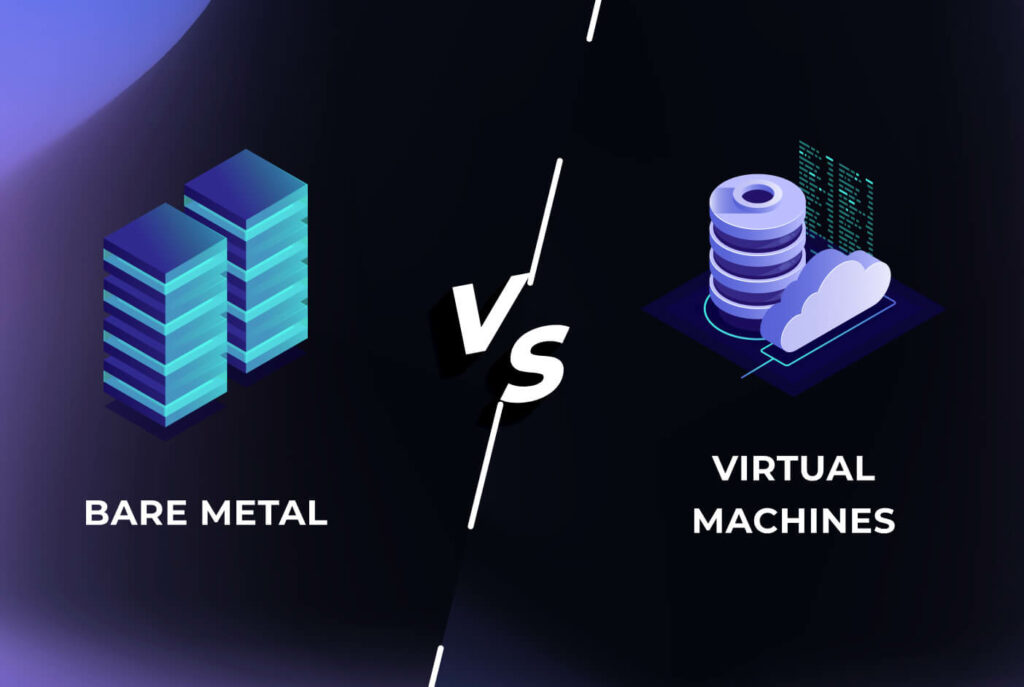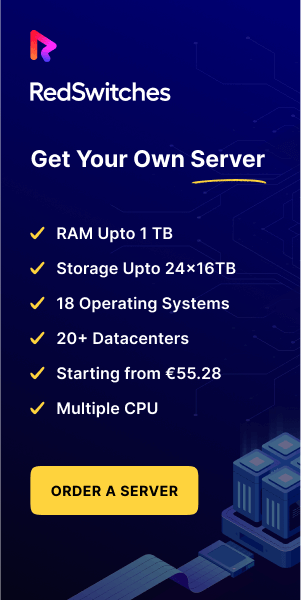Bare-metal servers and virtual machines are both powerful hosting solutions, making it harder to choose between the two.
Virtual machines run on bare-metal servers, but the added hypervisor puts a strain on performance and multi-tenancy can compromise security.
While they look the same, both are different solutions that accomplish very different outcomes for your business.
In this article, we will discuss the major points in the Bare-Metal vs VM debate to help you decide which one is better for you.
What Is a Bare-Metal Server?
Bare-metal servers are single-tenant hosting solutions that can power even the most demanding web hosting apps. The hardware components of bare-metal servers are not shared with any other users, unlike the hardware of shared servers.
Bare-metal servers are characterized by high processing power, stable and consistent performance, and ultimate security. They are also highly customizable and allow you to scale your dedicated server by adding new hardware.
Bare-metal servers are also commonly known as dedicated servers. Both of these terms refer to the same hosting technology.
When you host on a bare-metal server, you are the only user in that hosting space. Your hosted applications and services can therefore utilize 100% of the server’s hardware resources.
Besides fully dedicated computing resources, other main reasons why companies choose a bare-metal server are:
- Security and privacy
- Greater processing power and input/output operations per second (IOPS)
- More consistent disk and network I/O performance
- Quality of Service (QoS) that guarantees elimination of the noisy neighbor problem in a multitenant environment.
- Complete control over the server’s hardware and the software stack.
If your app is sensitive to performance and you wish to store data at a single-tenant device, the benefits of bare-metal are hard to beat.
Bare-metal servers are ideal for:
- Hosting critical applications that constantly demand high performance
- Hosting in large industries that cannot compromise on security
- IPTV streaming services
- Online education platforms
- Storage and backup solutions
- Media and news outlets
What Is a Virtual Machine?
Virtual machines are hosting servers based on software. Multiple virtual machines operate on a single bare-metal server.
A layer of software called a hypervisor is installed on the bare-metal server to create individual virtual machines on top of it. The hypervisor is also used to allocate the hardware resources proportionally to all virtual machines.
New virtual machines can be created instantly thanks to the hypervisor, and they can be removed at any given point if they are no longer needed.
Virtual machines created on one server share all the hardware resources, such as the CPU, GPU, storage, and RAM of the server. This makes virtual machines a multi-tenant hosting solution.
The performance of virtual machines is comparable to bare-metal servers. Their performance is however impacted by the addition of a hypervisor, as well as other virtual machines running on the same server.
In the context of bare-metal vs VM, virtualization offers the following advantages:
- Quick and simple deployments.
- Flexibility to add more server resources in times of high usage and match fluctuating traffic demands.
- Ability to control and optimize costs through a pay-as-you-go model.
- Little to no hardware-related server management.
- Quick and reliable snapshots and backups.
VMs are great, in that they solved many of the problems we faced with bare-metal i.e. better resource utilization, environment isolation, etc. Virtual machines are excellent for:
- Developers testing applications that temporarily need powerful hosting
- Startup applications and websites that are scaling up
- Websites that receive high traffic seasonally
- Companies trying to save on hosting costs
Bare-Metal vs VM: The Seven Main Differences
When considering bare-metal vs VM, you should consider this basic fact: Virtual machines operate on bare-metal servers. However, there are key differences between the two hosting solutions that make them different. Let’s go through the seven main differences between bare-metal and VMs:
#1. Tenancy
The biggest difference between bare-metals servers and virtual machines is the number of tenants hosting on them.
Dedicated or bare-metal servers are single-tenant solutions where only one user hosts their web services. The user can fully utilize the hardware components of their server.
Meanwhile, virtual machines are multi-tenant, because multiple of them run on a single bare-metal server at the same time. A higher number of tenants on a hosting server can negatively affect performance as well as security.
#2. Security
Like all discussions around hosting, security is an important aspect of the bare-metal vs VM debate.
To kick off the discussion you should know that bare-metal servers are the most secure hosting solution on the market.
They allow for custom security software to be put in place and defend the server from malware. And because there is no more than one user on the server, there are no hosting neighbors that can breach your server security.
In contrast, multiple virtual machines operate on one bare-metal server, and a security flaw in one of them can compromise the security of everyone hosting on the same server.
#3. Performance
Bare-metal servers and virtual machines run on identical hardware. However, an important point in the bare-metal vs VM discussion is the fact that the same hardware is used by more than one host to run multiple virtual machines.
When hardware is shared between users and just one of them demands more power for a short period, all other virtual machines on the same bare-metal server will experience a drop in performance.
The hypervisor used to create instances of virtual machines also uses part of the resources of the bare-metal server, leaving behind less available resources to share between the virtual machines.
#4. Cost
When it comes to bare-metal vs VM discussion, the cost of owning and maintaining the server(s) is an important factor.
There are two main ways hosting plans are billed: monthly or by the hour.
Monthly pricing plans are more common for bare-metal servers, which start at $100 per month. You will pay a fixed amount per month depending on the server configuration you have chosen. If you need more resources for your hosted services, you will have to pay for a hardware upgrade.
Meanwhile, virtual machines are typically billed on a utility-based system. They are billed by the hour, and you will only pay for the resources you are actively using. The cost can vary from just a few cents per hour to a few dollars if your resource usage is high.
When your hosted services on a virtual machine demand more resources, your server will automatically scale and the hourly cost will increase. The price will drop as soon as your resource usage goes down.
#5. Customization
Bare-metal servers can be customized at any time during your hosting contract. You can build your custom dedicated server to start with, or you can choose from standard dedicated hosting plans and upgrade them if you need to in the future.
Virtual machines are not customizable, as you cannot pick which components go in them. Rather, you get to choose from a variety of configurations, and you can add on more VM instances for higher performance. This process can happen automatically to accommodate bursts in performance.
This is an important consideration in bare-metal vs VM because it allows you to tailor the hosting solution to the requirements of your business applications.
#6. Deployment
Another major difference between bare-metal vs VMs is the time it takes to deploy a new server upon purchase.
When you buy a dedicated server, it can be delivered in as little as 4 hours or up to 24 hours from the time you buy it. It can take some time for you to migrate your files and start hosting on a dedicated server.
On the other hand, virtual machines are delivered almost instantly, since they are immediately created when you purchase them. You can start using your virtual machine right away.
#7. Scalability
Both bare-metal servers and virtual machines are easily scalable, but the way scaling is done is different for each of them.
To scale a bare-metal server (either up or down) requires physically swapping hardware components. If you are trying to scale up your server due to a surge in traffic on your website, you might just miss it and be left with unnecessary hardware at the end of the process.
While using virtual machines scalability is done much faster. Virtual machines immediately scale up the hardware resources to accommodate traffic peaks without interrupting your hosted services. This process happens automatically, and when the traffic surge is over the server resources go back to normal.
When discussing bare-metal vs VM, you should consider scalability because you don’t want your apps to go down because of the lack of server resources.
Let’s sum up the bare-metal vs VM debate in a table that allows you to see the major differences between the two solutions:
| Bare-Metal Servers | Virtual Machines | |
| Main Selling Points | Improved performance and complete data privacy | Near-instant scalability and cost optimization options |
| Server Resources | All resources (CPU, RAM, memory, bandwidth) available to a single user | Tenants host on the same device and share server resources |
| Deployment Time | Takes time to set up a new server. | Deployments are done in a matter of a few minutes |
| Performance | Consistently high performance | Less consistent performance due to multiple tenants and resource sharing |
| Customization | complete freedom for setting up both hardware and software | Limited software customization options due to the shared nature of the server |
| Security | Customization options and single tenancy ensure a high secure platform | Other tenants can cause security and privacy concerns |
| Hardware Maintenance | Complex without managed services | No hardware maintenance |
| Scalability | Scaling up or down requires hours depends on providers | Near-instant, on-demand scalability (both up and down) |
| System Recovery | Recovering from a mid-size disaster can take hours or even days | Recovery happens in minutes |
| Portability | Moving a physical server is a complex and lengthy task | You can easily move a VM across virtual environments or from one physical server to another |
| Pricing | A predictable (typically monthly) bill | Charges based on how much resources you use |
Conclusion
This bare-metal vs VM comparison covers the essential information about the two hosting solutions. While bare-metal servers and virtual machines are both excellent hosting solutions and provide high-performance platforms for hosting your web services, they are however suitable for different purposes.
If you have a clear idea of your requirements, you’d find that bare-metal servers are generally a good fit for your applications. VMs are more suitable for temporary solutions where you need to test an idea extensively in a custom environment.
Let us know where you stand in the bare-metal vs VM debate and what solution you prefer, and why.

